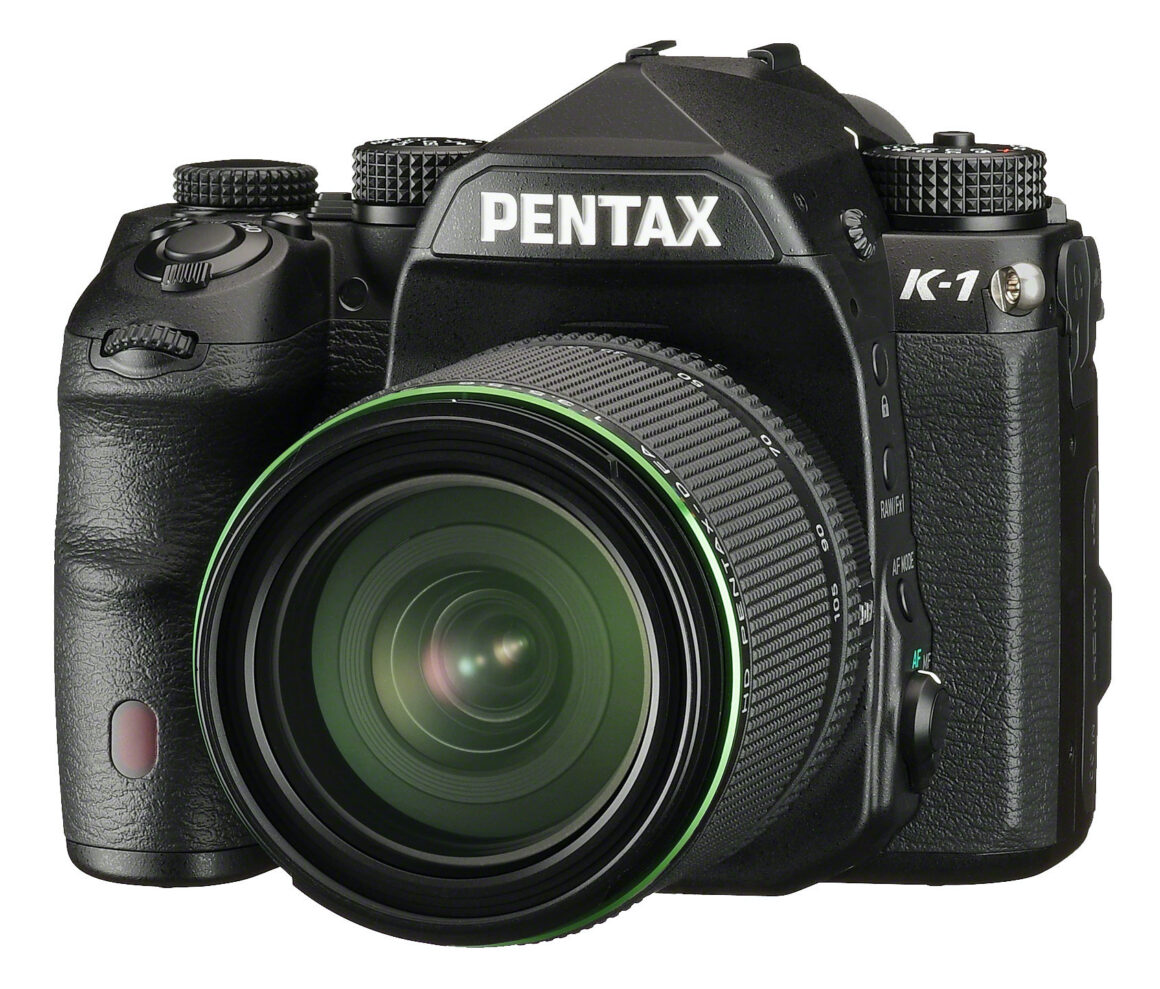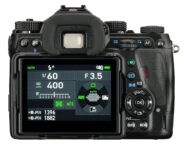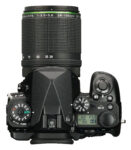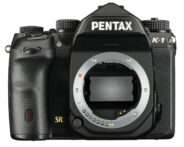Pentax K-1
35mm AF digital SLR camera • Discontinued
- Announced:
- · February 2016
- Production status:
- ● Discontinued
- Country of design:
- · Japan
- System:
- · Pentax K (1975)
Specification
| Format: | |
| 35mm full frame | |
Imaging sensor: | 35.9 × 24mm CMOS sensor |
Resolution: | 7360 × 4912 - 36 MP |
Sensor-shift image stabilization: | Yes |
| Pentax K [45.5mm] | |
| Shutter: | |
Type: | Focal-plane |
Model: | Electronically controlled |
Speeds: | 30 - 1/8000 + B |
| Exposure: | |
Exposure metering: | Through-the-lens (TTL), open-aperture |
Exposure modes: | Programmed Auto |
| Aperture-priority Auto | |
| Shutter-priority Auto | |
| Manual | |
| Physical characteristics: | |
Weight: | 925g |
Dimensions: | 136.5x110x85.5mm |
Manufacturer description
DENVER, Colo. February 17, 2016 – Ricoh Imaging Americas Corporation today announced the PENTAX K-1 full-frame digital single-lens reflex (DSLR) camera. The K-1 combines the performance of a full-frame sensor with unique, user-friendly PENTAX technology and convenience features loved by professional and serious amateur photographers the world over.
The foundation of the PENTAX K-1 is its large, full-frame image sensor. This AA-filterless CMOS sensor with 36.4 effective megapixels sets the stage for ultimate creativity, facilitating super-high-resolution images rich in gradation and superb in high-sensitivity rendition.
Built around the full-frame sensor is a compact, high-performance weather-sealed and dustproof body with features only found in PENTAX cameras. “The K-1 is a blend of advanced, full-frame performance with the kind of features and advancements that PENTAX users have come to know and love,” said Jim Malcolm, president, Ricoh Imaging Americas Corporation. “As a result, the K-1 creates a solution for full-frame shooters that is unique in the industry.”
Within its compact body, the PENTAX K-1 features several advanced technologies that help the photographer to produce top results in a wide variety of challenging conditions. SR II Shake Reduction is a newly refined and highly sensitive five-axis shake-reduction system that is capable of reducing camera shake with a compensation range of up to five exposure steps, allowing photographers to freely move and compose – and to focus on their subjects, not the gear. SR II also facilitates other advanced PENTAX-unique features such as AA Filter Simulator, which effectively eliminates moiré effect without the need for an anti-aliasing filter, while increasing sharpness and overall image quality. Key to great autofocus performance on the K-1 is the new SAFOX 12 autofocus mechanism with 33 autofocus points, assuring fast and accurate autofocusing, even in the most demanding shooting situations. A newly-designed optical viewfinder equipped with the famous PENTAX Pentaprism boasts a bright, nearly 100-percent field of view.
In addition to a long list of technological advancements, the PENTAX K-1 also features a number of convenience features, making camera operation fast and easy. Designed to move in ways never before imagined is the new Flexible-tilt LCD monitor—a first for any DSLR camera. This rugged yet highly adjustable display can be positioned to the desired angle horizontally and vertically, making it easy to shoot at challenging angles. Other significant firsts include the K-1’s Operation Assist Lights – small, white LEDs that facilitate camera operation in low-light environments, making it easy to change lenses, swap memory cards and adjust back-of-camera controls, and a Smart Function dial that allows photographers to easy select frequently-used functions without going into the LCD menu.
Current PENTAX lens owners will appreciate that they can incorporate their APS-C lens collection into their new PENTAX K-1 full-frame camera kit by utilizing the K-1’s Crop Mode, which offers settings in-camera for either APS-C or Full-Frame sized shooting, regardless of the attached lens. There is also an “auto” mode that detects the lens type and sets the camera accordingly.
Upon launch, PENTAX is offering 12 full-frame compatible lenses, including two new models being announced concurrent with the K-1 camera: the HD PENTAX-D FA 15-30mm f.2.8 ultra-wide angle zoom lens and the HD PENTAX-D FA 28-105mm f/3.5-5.6 compact, lightweight zoom lens. (Note: separate news releases have been issued today to provide details on each lens).
| Pricing and Availability |
The PENTAX K-1 camera will be available April 2016 at www.ricohimaging.com and retail outlets nationwide for a manufacturer’s suggested retail price of $1,799.95.
Main Features
1. High-resolution, fine-gradation images supported by approximately 36.4 effective megapixels
The K-1 features an AA (anti-aliasing) filterless design that prioritizes image resolution, as well as the new PRIME IV imaging engine, which is capable of 14-bit RAW-format image recording. The K-1’s unique full frame sensor and imaging engine design also allows for super-high-sensitivity shooting up to ISO 204800, producing beautiful, high-resolution images.
2. New-generation SR II five-axis system
In-body SR II mechanism assures optimal shake reduction performance
The SR II (Shake Reduction II) five-axis mechanism enables accurate control of the large full-frame image sensor with all compatible PENTAX interchangeable lenses.* In addition to camera shake caused by pitch and yaw, it effectively compensates for camera shake caused by horizontal and vertical shift, as well as camera shake caused by roll, which is difficult to deal with by lens-installed shake reduction mechanisms. Even when taking a panning shot, this system automatically detects the direction of the camera’s movement, and efficiently controls the SR II unit to always produce the best image possible.
Pixel Shift Resolution System with a new motion correction function
This system uses the latest super-resolution technology, which captures four images of the same scene by shifting the image sensor by a single pixel for each image, then synthesizes them into a single composite image. Compared to the conventional Bayer system, in which each pixel has only a single color data unit, this innovative system obtains all color data within each pixel. It incorporates a new motion correction function, which automatically detects a moving object during continuous shooting.
Innovative AA filter simulator to minimize moiré
By applying microscopic vibrations to the image sensor, the K-1's AA (anti-aliasing) filter simulator provides the same level of moiré reduction as an optical AA filter.
Supportive shooting functions
Since the K-1’s SR II unit has a flexible design that tilts the image sensor unit in all directions, it provides a host of handy shooting functions, including auto level compensation, image-composition fine-adjustment, and AstroTracer, which simplifies advanced astronomical photography using a built-in GPS module.
3. Flexible tilt-type LCD monitor to accommodate various shooting angles
The K-1 features a newly designed, Flexible-tilt LCD monitor, which tilts horizontally, vertically or diagonally with a single action, without deviating from the lens’s optical axis. 35 degrees of horizontal and 44 degrees of vertical adjustment can be achieved; the LCD panel can even be laid flat up or down. The 3.2-inch LCD monitor features a tempered-glass front panel for added durability, a unique air-gapless construction effectively reduces reflection, and a new Outdoor View Setting mode allows the user to instantly choose the desired monitor brightness level.
4. Newly developed SAFOX 12 with 33 sensor points and full-frame-proportioned AF frame
The SAFOX 12 AF sensor module features 33 AF sensors (25 cross-type sensors positioned in the middle). The center sensor and the two sensors located just above and below it are designed to detect the light flux of an F2.8 lens, making it easy to obtain pinpoint focus on a subject when using a large-aperture lens.
5. Upgraded PENTAX Real-Time Scene Analysis System, with application of artificial intelligence technology
The K-1’s advanced PENTAX Real-Time Scene Analysis System performs near-instant analysis of exposure, color, movement and other factors. Combined with a breakthrough artificial intelligence technology called deep learning, the K-1 instantly optimizes settings for even the most difficult shooting situations.
6. Easy-to-focus optical viewfinder with nearly 100-percent field of view
Newly developed for its 35mm full-frame design, the K-1’s optical viewfinder provides a nearly 100-percent field of view and an approximately 0.7-times magnification. A Natural Bright Matt III focusing screen allows ease of focusing and a true-to-life rendition of defocused areas in the viewfinder image.
7. High-speed continuous shooting with a top speed of approximately 4.4 images per second
The K-1 has a larger shutter unit that easily accommodates the camera’s full-frame image sensor and provides high-speed, high-accuracy control of the mirror unit. A high-speed data transmission system incorporated in the PRIME IV imaging engine allows the user to continuously record as many as 17 images in the RAW format (or a maximum of 70 images in the JPEG Best format) in a single sequence, at a top speed of approximately 4.4 images per second.
8. Supportive shooting functions to improve picture-taking efficiency and operational comfort
- Operation assist light function, which provides LED lights above the lens mount, behind the LCD monitor, at the memory car slot, and at the cable switch terminal to facilitate fast and easy operation in poorly lit settings.
- Key lock function, which prevents erroneous operation of the four-way controller and other exposure-related control buttons.
- Smart function, which allows the user to swiftly choose and set desired functions using just the function dial and the set dial on the camera’s upper panel, without referring to the menu screen on the LCD monitor.
- Control panel customize function allows the user to change aspects of the on-screen menu.
9. Compact, solid body with dustproof, weather-resistant construction
Constructed of sturdy yet lightweight magnesium alloy with the inclusion of 87 sealing parts in the body, the K-1 also boasts a dustproof, weather-resistant and cold-resistant construction.
Other Features
- Wi-Fi operation allowing camera control and image transfer to tablet or smartphone via the free ImageSync app
- Full HD movie recording at 1920 x 1080 pixels in the H.264 recording format
- Built-in GPS module and electronic compass
- High-grade DR II (Dust Removal II) mechanism for effective elimination of dust on the image sensor using ultrasonic vibration
- Crop mode with a choice of image area from AUTO, FF (Full Frame) and APS-C, to accommodate different types of lenses
- Clarity control and Skin Tone correction functions, a pair of the latest image processing technologies developed by RICOH Central Laboratory
- HDR (High Dynamic Range) shooting mode with RAW-format data filing, usable in handheld shooting
- The PENTAX-invented hyper operating system for quick, accurate response to the photographer's creative intentions
- Dual SD card slots for memory card flexibility (compatible with SDXC UHS-1 speed class in SDR104 buss speed mode)
- Compensation of various parameters: lens distortion, lateral chromatic aberration, diffraction, and brightness level at image-field edges. Fringe effect compensation is also available in RAW-format processing.
- Compatibility with PENTAX Image Transmitter 2 tethering software (Software update required from RICOH IMAGING official website)
- Digital Camera Utility 5 software (latest version) included
Optional Accessory
D-BG6 Battery Grip
This battery grip is designed to facilitate vertical-position shooting with the PENTAX K-1 camera body. It provides a shutter release button, a set of control buttons (AE lock, AF, ISO, exposure compensation, green), a preview lever, and dual electronic dials — just like those provided on the camera body. It also features the dustproof, weather-resistant construction identical to the PENTAX K-1 camera body. In addition to the dedicated lithium-ion rechargeable batteries, it also accepts six AA-size batteries.
Pentax K-1 special editions (1)
- Pentax K-1 Limited Silver (2000 units) - August 2017




